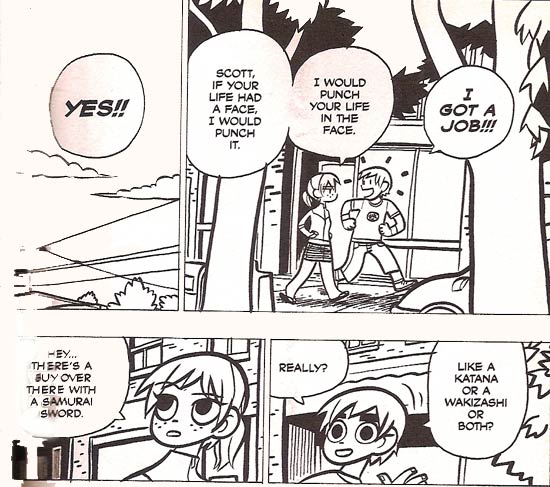Read This: Scott Pilgrim Gets It Together

NOTE: Very little of Scott Pilgrim Gets It Together makes it into the movie, and what does turn up does so in a highly altered/condensed form.
Which is a bit of a shame, really, because this installment of the story puts Scott Pilgrim’s love for Ramona to a test more real and more serious than the battles with the seven evil exes—the return of his best friend from high school, the girl he never dated but maybe could’ve/maybe should’ve. Also, he’s working on proving to Ramona that he’s not a slacker by getting a job… which turns out to be way too easy, something we could say about a lot of Scott’s life. The other aspect of this book that is most unfortunately lost from the movie is the nuance of Scott’s friendship with Kim (seen above)—that also goes back to high school (as we saw back in Scott Pilgrim vs. the World). Events in this book make it clear that the urban fantasy elements framing Scott and Ramona’s relationship are “real” enough that Kim can experience them, too—so this isn’t all just in Scott’s head.
It started building up in Scott Pilgrim and the Infinite Sadness, but this is the point where it becomes so clear Bryan Lee O’Malley is using shonen manga and video game metaphors to tell a very serious story about emotional maturity. One of my favorite bloggers, Chris Sims, wrote a fascinating essay last week about why making the Archie gang grownups doesn’t work: “If you make him the typical aimless twentysomething, his relatable problems suddenly aren’t that funny.” And that may be true of the Archie characters because of the decades of accumulated cultural relevance they’ve acquired, but Scott Pilgrim and his friends don’t have that restraint; we’re getting to know them for the first time, so while it may be disconcerting to have the comic veer from “Big Battle as metaphor for relationship issues” to “serious conversations about relationship issues,” it’s a narrative bait-and-switch that totally works.
17 August 2010 | read this |

 Our Endless and Proper Work is my new book with Belt Publishing about starting (and sticking to) a productive writing practice.
Our Endless and Proper Work is my new book with Belt Publishing about starting (and sticking to) a productive writing practice. 
